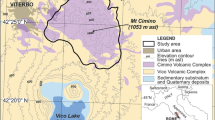Abstract
The Musashino Terrace and the Shitamachi Lowland, the main urban areas in the Tokyo metropolis, are in the eastern part of Tokyo and are underlain by thick Quaternary sediments. The geologic structrue of these sediments has a general strike of WNW—ESE, with a gentle dip to the east in the western part of the Musashino Terrace, and strikes generally to the E—W with a gentle dip to the north in the eastern part of the terrace and strikes WNW—ESE to N—S with a very gentle dip to the east in the Shitamachi Lowland. The basal sediments in this area consist chiefly of massive thick silty layers, whereas the sediments overlying them consist of alternating layers of silt, sand, and gravel, which act as confined aquifers throughout the Musashino Terrace and the Shitamachi Lowland. Confined groundwater systems are being developed in the Tama District, the western part of the terrace, and are mainly recharged with river water from the Tama River. The unconfined groundwater system is being developed in the surface layers such as terrace sand and gravel formations and the Kanto Loam Formation. These confined aquifers that are being developed throughout the terrace and the lowland have been exploited for household water supplies and industrial and air-conditioning use for nearly seven decades. The heavy utilization of the confined groundwater, however, has caused a major lowering of groundwater levels. As a result of the lowering of groundwater levels, land subsidence has occurred all over the Lowland and the terrace. At this time the national government and the Tokyo Metropolitan Government restricted groundwater withdrawals for industrial, air-conditioning use and the others except for household supply. Owing to these restrictions, not only have the water levels recovered, but land subsidence has rapidly declined since around 1973.
Similar content being viewed by others
References Cited
Aihara, S., H. Ugata, K. Miyata, and Y. Tanaka, 1969, Problems on the groundwater control in Tokyo: Proceedings of the Tokyo symposium on land subsidence, Land Subsidence, v. 2, Publ. No. 89, IASH-Uneso, p. 635–644.
Inaba, Y., S. Aoki, T. Endo, and R. Kaido, 1969, Reviews of land subsidence researches in Tokyo: Proceedings of the Tokyo symposium on land subsidence, Land Subsidence, v. 1, Publ. No. 88, IASH-Uneso, p. 87–98.
Ishii, M., F. Kuramochi, and T. Endo, 1976, Recent tendencies of the land subsidence in Tokyo: Proceedings of the second international symposium on land subsidence, Anaheim, CA, p. 25–34.
Kaizuka, S., 1958, Landform evolution of the Kanto Plain: Geogr. Rev. Jpn. v. 31, p. 1–27.
Kawai, K., 1961, Economic geological study on the southern Kanto gas-producing region: J. Jpn. Assoc Pet. Technol. v. 26, p. 212–266.
Yabe, H., 1925, The great Kwanto earthquake of September 1, 1923, geologically considered, the second preliminary report: Saito Hoonkai Report work, no. 2, p. 33–44.
Author information
Authors and Affiliations
Rights and permissions
About this article
Cite this article
Endo, T. Confined groundwater system in Tokyo. Environ. Geol. Water Sci 20, 21–34 (1992). https://doi.org/10.1007/BF01736107
Issue Date:
DOI: https://doi.org/10.1007/BF01736107




